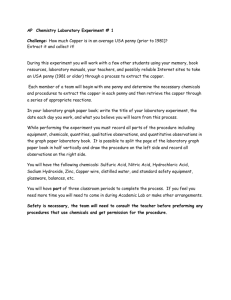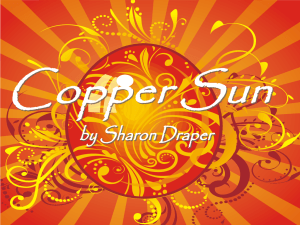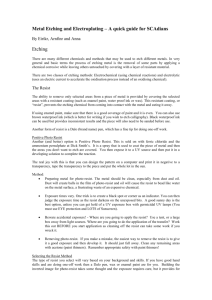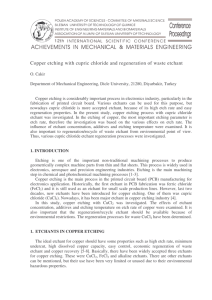cms/lib3/WA01001855/Centricity/Domain/1546/Electrolytic Copper
advertisement
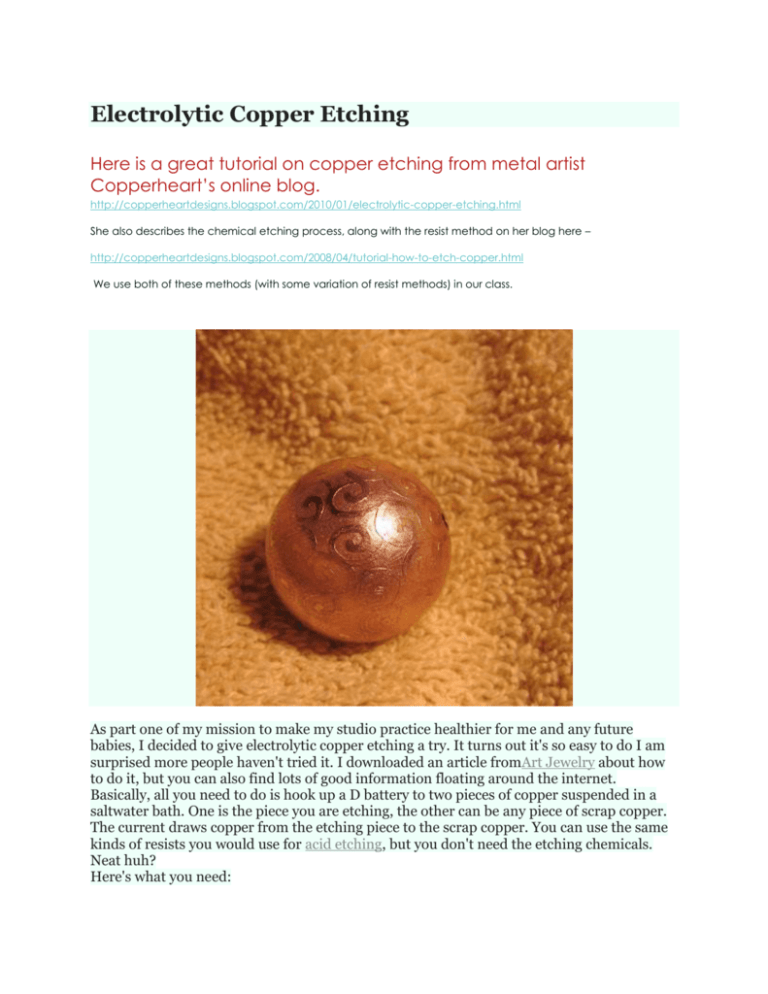
Electrolytic Copper Etching Here is a great tutorial on copper etching from metal artist Copperheart’s online blog. http://copperheartdesigns.blogspot.com/2010/01/electrolytic-copper-etching.html She also describes the chemical etching process, along with the resist method on her blog here – http://copperheartdesigns.blogspot.com/2008/04/tutorial-how-to-etch-copper.html We use both of these methods (with some variation of resist methods) in our class. As part one of my mission to make my studio practice healthier for me and any future babies, I decided to give electrolytic copper etching a try. It turns out it's so easy to do I am surprised more people haven't tried it. I downloaded an article fromArt Jewelry about how to do it, but you can also find lots of good information floating around the internet. Basically, all you need to do is hook up a D battery to two pieces of copper suspended in a saltwater bath. One is the piece you are etching, the other can be any piece of scrap copper. The current draws copper from the etching piece to the scrap copper. You can use the same kinds of resists you would use for acid etching, but you don't need the etching chemicals. Neat huh? Here's what you need: D battery D battery holder Alligator clips Heavy copper wire (14g. is good) Copper to be etched Scrap copper Pure salt (kosher or canning and pickling salt) Plastic or glass container Resist (pnp film, stop-out varnish, asphaltum, etc) To get set up, you need to attach your alligator clips to the lead wires on your battery holder. My friend Paul helped me out (thanks Paul!) because even though I know all about silver soldering I know nothing about soldering electrical components. Then you make a saturated salt solution by dissolving as much salt as you possibly can in water. To get your metal ready, you need to get the piece you will be etching really nice and clean by scouring it with a scrub pad or heating and pickling it, then draw your design on with whatever resist you are using. I was surprised when I first started experimenting with this technique to find that the salt water is just as hard on the resist as the ferric chloride was. Permanent marker didn't work at all, and the sharpie paint pen I used to use for beads works ok but doesn't last long enough to get a good deep etch, so I am back to using the stop-out varnish (check out my acid etching tutorial for more info on different resists) The scrap copper just needs to be cleaned off with a scrub pad or brass brush to remove any residue, then it's ready to go. Once your metals are ready, fill a plastic or glass container with the salt solution, then attach your two pieces of copper to copper wires and hang them from the sides of the container so they are submerged in the solution. Attach the positive alligator clip to the piece you want to etch and the negative clip to the scrap copper. You will immediately see little bubbles rising from the scrap copper, and within minutes the water will start to get cloudy and reddish brown with copper (Note: Don't pour this water down the drain! collect it and talk to your local waste management people about how to dispose of it. It's not hazardous to handle but it's not good to put copper into the water supply!) It takes about an hour or more to get a really nice deep etch. Depending on what effect you are looking for, you can get a visible etch in about a half hour. I need to do some more experimentation, but my first piece has a visible etch so I consider it a success. Overall I am very pleased with this project. It was easy to do and safe, without the mess of ferric chloride and it cost about seven dollars for all the supplies to get started. I am planning on doing a lot more copper etching with this technique, so I should have lots of new etched copper jewelry and beads coming soon! http://copperheartdesigns.blogspot.com/2010/01/electrolytic-copper-etching.html





